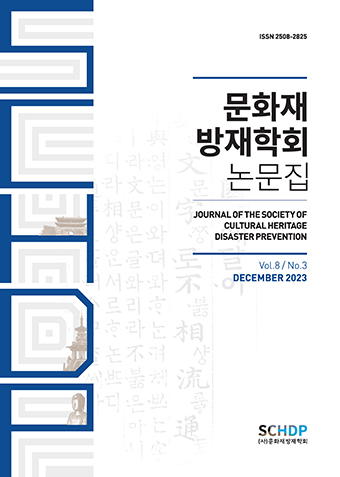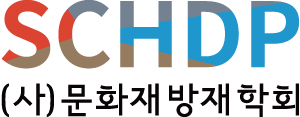Instructions for Authors
Guidelines for writing a paper by the Society of Cultural Heritage Disaster Prevention
I. Guidelines for Writing Papers
1. A paper should meet the purpose of the Society of Cutural Heritage Disaster Prevention (the ‘Society’), have originality and be unpublished.
2. When submitting a paper, the corresponding author must be specified and he or she is responsible for various matters such as submission, revision, supplementation, payment for evaluation and publication, and submitting manuscripts and transferring copyright. It should be the principle that the corresponding author and lead author belong to members of the society.
3. Manuscript for evaluation should be written according to the sample of Editorial Board for Evaluation manuscripts (the “Committee”).
4. Configuration of the paper are as follows: (1) title, (2) English title, (3) the name of the author, (4) English name of the author, (5) abstract, (6) Korean key words, (7) English abstract, (8) English key words (9) introduction (10) body, (11) conclusion, (12) reviews (13) references and (14) appendix. It makes it a rule to follow this order. The detailed information about writing a paper should be in line with ‘II. Details in writing a paper’
5. Submitted manuscripts will not be returned in any cases.
6. (Thesis examination fee) When submitting a paper, thesis examination fee assigned by the study should be paid and it is not refunded in the cases of return, withdrawn and judgment to be not adopted. Thesis examination fee is 30,000won for general, and 50,000won for urgency.
7. It depends on decisions of commission to adopt submitted paper and does not disclose the names of the judges.
8. If corresponding author does not submit revised paper in one month, submitted paper will be regarded as impossible to be adopted. It is 2 months for the re-examination.
9. In case of addition or removal of co- authors, the corresponding author should submit written consent including their signature.
10. In the case of the decision to be adopted, the corresponding author should submit final copy in line with the samples and template offered by committee and hand over the copyright.
11. (Thesis examination fee) the corresponding author should pay examination fee in time when submitting the final paper. For less than 8 pages, general fee is 100,000 won and emergency is 150,000 won. For more than 8 pages, it is 20,000 won for general per page and 40,000 won for emergency per page.
12. The authors have full responsibility for the content of the paper and should comply with the code of research ethics of the society.
13. When there is inquiry for processing status, you can make a inquiry to the committee. A formal objection can be submitted in one month after the decision of confirmation.
14. Other details can be referred from rules and regulations of the committee.
II. Detailed Information for Writing a Paper
15. Manuscripts should be written in Korean. In case of any ambiguity, English or Chinese characters can be written in brackets.
16. The title of the paper should be succinct within the range of 10 words. Key Words should be over the five words and less than 10 words.
17. Korean and English abstract briefly describes the core of the body, does not quote the reference number and must not be included tables, figures and photographs.
18. (Number and quantity of units) Using Arabic numbers and SI units for quantity shall be required.
19. (Formula) The formula is placed to the left and formula number should be in order in which they appear in the body. And it has to be placed to the right of the line. Above and below the formula, there should be a blank line. When cited the formula, it can be expressed as such; ‘Equation (1)’.
20. (Tables, figures, and photos) Writing tips for tables, figures, and photos are as follows:
① The numbers of the tables, figures, and photos are numbered in order. It should be place on top of or bottom of the page that is cited.
② The title of tables, figures, and photos should be written in English as shown below, and title of the table should be placed in the top of the table. The title of figures, and photos should be placed the below. (Eg, 1) Table 1. Damage cost (Eg, 2) Fig. 1. Bridge damage examples
③ When citing tables, figures, and photos in the body, it should be written in English such as ‘Table 1’ or ‘Fig. 1’.
④ The thickness of the line and the size of the letters and symbols used in tables, figures and photos should be sharp enough to be seen correctly in case of printing.
⑤ If you are using a colored picture, it should be enough to be distinguished when printed in black.
⑥ The format of the table and other factors should be comply with the examples in template.
⑦ Blank line should be placed above and below tables, figures and photos.
21. (Reference) References writing tips are as follows:
① References should be written in English and placed and arranged in order based on author`s name.
② Notation of reference should follow the manner below depending on the type of references.
[1] Kim, S.-G., Matahari, M.P. (2010). “Analysis of congenital brain damage.”,Journal of Brain Vibration, Vol.83, No.1, pp.1053-1063.
[2] Hitler, A. (1943). My Combat.Nazi Press, Berlin, Germany.
[3] Cloudy, M.R. (2011). Vibration and Panic of Seoul, Ph.D. Dissertation, Texas State University, US.
[4] Lilly, A., Rittle, B.C., Jesus, G.D. (2001). “Development of national terror machine.”, Proceedings of the 25th International Congress on Panic Attack, New York, US, pp.1102-1125.
[5] Copper, S.D. (1978). Nonparametric Study on the System Property Identification of Containment, IAEA, R-TA-7084, New York, US
[6] Dolche, S. (2001) Nondestructive damage detection in civil engineering structures, US Patent No. 1454210.
③ Notation for other types of references not mentioned above should follow generally accepted conventions in the academic community.
④ When citing reference in the body of study, comply with the following representation.
(Eg, 1) Copper (1998)...; Lerry et al. (2010) is ... (two or more authors)
(Eg, 2) ...it is discovered that it led to the disastrous consequences if it fails to forget (Zimmerman, 1984; Keplan et al., 2001; Kim, 2003).
22. (Evaluation papers) Manuscripts for evaluation paper should be written in first and comply with the samples provided by the Commission.
23. (Paper for publication) Manuscripts for publication should comply with the samples provided by the Commission.
24. (Others) otherrelevant information that is not described in the detailed instructions should take a reference from template provided by the Commission. In case of any other issues, contact Association office.
Instructions for Authors by the Society of Cultural Heritage Disaster Prevention
Article 1 (Purpose) The purpose of this regulation is in regulating various matter regarding submitted collection of dissertations (‘collection of dissertations’) in accordance with the rule of the editorial board of the Journal of the Society (the “Society”).
Article 2 (Qualification for submission) The author and corresponding author should be the members of the society.
Article 3 (Corresponding author) the paper submitted to collection of dissertations should be designate corresponding author. Corresponding author should take full responsibilities in submission, revision, supplementation and payment for evaluation and publication.
Article 4 (Written paper) The paper submitted to collection of dissertations should comply with the guideline provided by committee.
Article 5 (Paper Submission) Paper Submission is available in all times and can be done by Paper Submission system Paper Submission system Homepage address : http://schdp.org/thesis/ThesisForm.asp
Article 6 (Thesis examination fee) Corresponding author should pay examination fee designated by the society and its refund is not allowed in any cases such as withdrawn, return or unavailable to publish.
Article 7 (Paper application) The date of receipt of the paper is the completion date of payment.
Article 8 (Paper retrocession) The paper that is not in accordance with paper submission provision by the society is subject to be rejected to be published.
Article 9 (Paper re-posting) Paper re-posting follows procedure according to submission provision. Examination fee should be completely paid.
Article 10 (Paper return) Received or rejecting paper will not be returned in any case.
Article 11 (Paper publication) Authors of the received paper will be released to judges and editorial board in order to review the paper.
Article 12 (Paper adoption) Publication of the accepted paper depends on the procedure designated by the regulation set forth by the committee.
Article 13 (Final thesis manuscript)
1. If receive paper turned out to be available to be published, the final paper should be submitted in line with the format designated by the committee.
2. If final paper is not submitted in one month from the judgment date, it will be regarded as a withdrawal.
Article 14 (Copyright and take over) Copyright of published paper is in the society. Corresponding author representing all authors should submit the form of take over. If there is no submission of takeover, it will be regarded as a withdrawal.
Article 15 (Manuscript Checklist) Corresponding author representing all authors should submit the Manuscript Checklist of take over. If there is no submission of takeover, it will be regarded as a withdrawal.
Article 16 (Paper publication fee) Corresponding author should pay publication fee before the publication. If the payment were not made within the deadline, it will be regarded as a withdrawal.
Article 17 (Paper withdrawal) Corresponding author can withdraw the paper before the publication. However, it is in the middle of typesetting, corresponding author should pay all typesetting payment as well as the payment for delay of delivery.
Article 18 (Change of author) Adding, deleting or changing the order of the name of the author can only be available before publication. However, corresponding author should submit written consent by all authors.
Article 19 (Paper appearing order)
1. The final adopted papers should be appeared in orders of submission date of final manuscript and copyright document. However, the order can be adjusted according to the decision of the editor-in-chief or the committee.
2. In case of delay of copyright document or publication payment, it may be a delay in the publication of papers.
Article 20 (Paper reprint) If corresponding author requests reprints, it can be reprinted as a condition of bearing expense designated by the committee.
Article 21 (Type of Publication) Copyright of published paper is submitted to a variety of the paper. All papers will be classified into research paper and technical paper.
Article 22 (Responsibility and Ethics) Responsible for published or submitted paper is solely in the author. The author should comply with responsibility and ethics of the society.
Article 23 (Revision of Rules) The revision of the rules can be done with majority of agreement by attending editorial board. Editorial board should be attending more than a third of the member. If there is a tie, editor-in-chief has a right to determine.
Article 24 (Fiscal year) Information that is not mentioned in the regulations should follow the decision of the editor-in-chief or the committee.


 Journal of the Society of Cultural Heritage Disaster Prevention
Journal of the Society of Cultural Heritage Disaster Prevention




